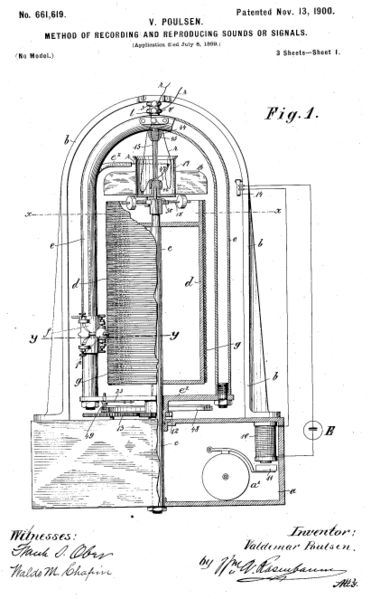http://www.youtube.com/watch?gl=GB&hl=e ... Obscg&NR=1
RJ
Pretty much the same way that info is recorded on tape, with the iron oxide on acetate or mylar tape base in place of the wire. There's an electromagnet (recording head) the wire passes over, and the sound in the form of electric signal magnetically re-arranges the iron particles in patterns that can be played back.Zeppy wrote:I've always been curioius about the technology, but too lazy to look into how it actually works...anyone willing to educate the curious but unmotivated? How is the info recorded onto the wire?
The first wire recorder was the Valdemar Poulsen Telegraphone of the late 1890s, and wire recorders for law/office dictation and telephone recording were made almost continuously by various companies (mainly the American Telegraphone Company) through the 1920s and 1930s. They were most famously introduced as consumer technologies after World War II.And here’s a patent from 1900:
Wire recording’s most widespread use was in the 1940s and early 1950s, following the development of inexpensive designs licensed internationally by the Brush Development Company of Cleveland, Ohio and the Armour Research Foundation of the Armour Institute of Technology (later Illinois Institute of Technology). These two organizations licensed dozens of manufacturers in the U.S., Japan, and Europe.
Consumer wire recorders were marketed for home entertainment or as an inexpensive substitute for commercial office dictation recorders. However, the introduction of consumer magnetic tape recorders around 1948 quickly drove wire recorders from the market.

(Click the image or this link for the full-size version.)
It’s definitely an interesting and largely forgotten audio recording technology.Magnetic Format
Poulsen’s original telegraph one and indeed all very early recorders placed the two poles of the record/replay head on opposite sides of the wire. The wire was thus magnetized transversely to the direction of travel. This method of magnetization was quickly found to have the limitation that as the wire twisted, there were times when the magnetization of the wire was at right angles to the position of the two poles of the head and the output from the head fell to almost zero.
The development was to place the two poles on the same side of the wire so that the wire was magnetized along its length or longitudinally. Additionally, the poles were shaped into a ‘V’ so that the head wrapped around the wire to some extent. This increased the magnetizing effect and also increased the sensitivity of the head on replay because it ‘collected’ more of the magnetic flux from the wire. This system was not entirely immune to twisting but the effects were far less marked.
The longitudinal method survives into magnetic tape recording to this day.
Media Capacity and Speed
Compared to later tape recorders, wire recording devices had a high media speed, made necessary because of the use of the solid metal medium. The wire reels were recorded or listened at nominally 24 inches per second (610 mm/s), making a typical one-hour reel 7,200 feet (approx. 2195 m) long. This enormous length was possible on a spool of under 3 inches in diameter because the wire was nearly as fine as hair. Since the wire was pulled past the head by the take up spool, the wire speed increased as the diameter of the spool increased.
Wires also came in different lengths, such as 15 or 30 minutes. After recording or playback, the reel had to be rewound, because, unlike the later tape recorders, the take up reel on most wire recorders was not removable. In practice, the fine wire easily became tangled and snarls were extremely difficult to fix. Editing could be accomplished by cutting the wire and tying the ends together, with the knot sometimes welded with the tip of a lit cigarette. Although wire was difficult to edit, it provided tremendous advantages over trying to edit material recorded on transcription disks, which was usually accomplished with stopwatches, multiple turntables and a lot of patience. The first regularly scheduled network radio program produced and edited on wire was CBS’ “Hear it Now” with Edward R Murrow. Recording wire would run through a slit on the record and playback head which on many machines moved up and down like a fishing reel to ensure the wire was placed on the take-up reel evenly (on high-end machines moving wire guides performed this function). Tied-knot edits would cause the wire to pop out of the slit in the head, but it would drop back into the slit after the edit passed. This brief dropout could make editing music problematic.
Fidelity
The audio fidelity of wire recording made on one of these post-1945 machines was comparable to a 78-rpm record or one of the early tape recorders. The Magnecord Corp. of Chicago briefly manufactured a high fidelity wire recorder intended for studio use, but soon abandoned the system to concentrate on tape recorders.
Some wire recorders were also used in aircraft cockpit voice recorders and flight data recorders beginning in the early 1940s, mainly for recording radio conversations between crewmen or with ground stations. In this capacity, being somewhat more resilient than magnetic tape, wire recorders survived somewhat later, being manufactured for this purpose through the 1950s and remaining in use somewhat later than that. There were also wire recorders made to record data in satellites and other unmanned spacecraft of the 1950s to perhaps the 1970s.
— MordEth